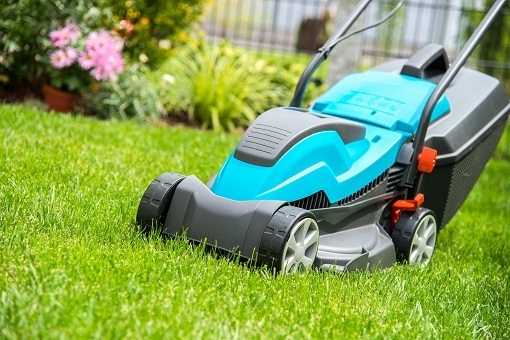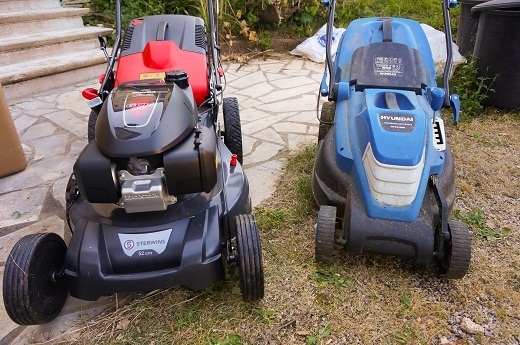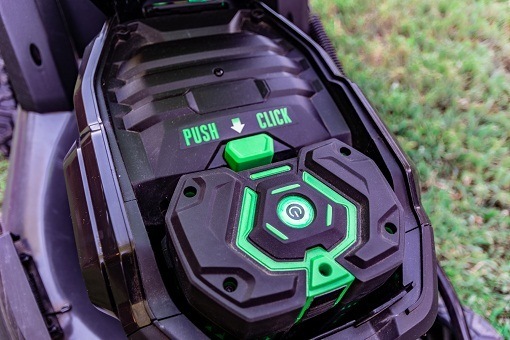Electric lawnmowers were fun lawnmowers, even more so. They were costly, heavy, cumbersome, underperformed, and underpowered their noisy, stinky, smoky gas-chugging equivalents. But that's changed. Now battery-powered lawn mowers provide homeowners and landscapers a cleaner way to mow the yard, competing for gas-powered lawn mowers in cost and performance --and a few can even cut the yard autonomously!
Why Mow Electric?
Gas mowers were the best choice to mow lawns for quite a long time. Some of the first gas-powered lawnmowers arrived as early as 1902. However, the engines that power them are noisy and some of the most polluting out there as they don't have emissions reduction technology.
Electric mowers, which were initially underpowered--even when corded, have come a long way. The battery power given by lithium-ion technology has boosted up and become less costly. Also, the brushless motors which power them are becoming stronger. Consumer Reports observed that electric lawnmowers could rival gas versions in 2017, and costs have come down considerably since then.
Are electric Lawnmowers any good?
Battery-powered electric mowers are now like gas-powered mowers, as they can go anyplace other mowers can. Battery-powered lawn mowers are getting more affordable with gasoline mowers at the store, and have a far lower lifetime cost as they don't require oil or gas to operate.
Electric lawnmowers offer the same set of attributes that gas-powered mowers do. They carry grass-cutting height options and grass cutting management, including bagging, mulching options, side discharge, self-propelled and riding mower choices, push mower, and lots of conveniently folding down for storage. They offer benefits over gas-powered mowers, also. Chief among them reduced operating costs and less maintenance. They are also quieter to work, so you are more likely to hear children playing behind you when you're mowing the yard. They are also easy to move since the engine and batteries for an electric lawn mower are lighter than the gas mower's motor and gas.
The cost of running an electric lawn mower is significantly less expensive than a gas mower. Back in 2017, WiseBread estimated that the expense of electricity to power a push gas mower when gasoline costs $2.30 a gallon is $1.50 per half-acre. To get a battery-powered mower, it costs 10 cents to mow a half-acre assuming electricity charges 11 cents per kilowatt-hour, every year that equates to $24.00 for a gasoline mower and $1.60 for a battery-powered mower. Maintenance charges for electric mowers are much lower compared to gas-powered mowers, also. Just think about it: no spark plugs, oil, or filters to change. Just sharpening the blade and possibly change the batteries after 5 years of usage. Within 10 years, that adds up to $250 of maintenance for a gas mower, compared to $175 or less for a battery-powered mower.
The total use costs of an electric mower over ten years, including maintenance and fuel, are approximately $191. The total use costs for a gas-powered mower, including maintenance and fuel within 10 years are much higher, at $490. When you think that the most affordable battery-powered electric mowers available in retail shops like The Home Depot and Lowes have models such as the Sun Joe 14-inch 28-Volt Battery Push Mower, that runs $165.99 at Home Depot, they are cost-competitive with gas-powered mowers. The most affordable gas-powered mower at Home Depot is the Yard Machines 20-inch, 125 cc Gas Push Mower, which runs $165.00.
How long do Electric lawnmower batteries last?
This is a multi-faceted topic. Lithium-ion batteries have run times and lifetimes. As previously stated, a mower battery should have five-years of battery life. If replaced, it may increase the mower's life to 10 or more years. Based on the voltage and amp-hours (Ah) provided from the battery, prices vary significantly, like this lawnmower run time. Most mower battery units have a cut time between 30 and 60 minutes, which will allow a homeowner to float between a half to a third of an acre. For those who have a small lawn, you won't need a giant battery or mower. For a larger lawn, consider a mower with a higher Ah battery pack and higher voltage. If you need a self-propelled electric lawn mower, you may require an even larger battery.
Another thing to consider when buying a battery-powered lawn mower is if you want it to be part of an electric gear ecosystem. Firms like Ryobi, Stihl, DeWalt, and Black & Decker, offer electric lawnmowers and electrified tools such as weed whackers and trimmers and drills and saws. These provide opportunities to share chargers and batteries, one of many pieces of equipment.
What's the best electric lawn mower?
EGO's line of 21-inch deck lawnmowers is the topmost listings in 2020. The mowers provide the same torque and power of a gas mower with their 56-volt 7.5 Ah batteries, which provide up to 60 minutes of mowing and a 40-minute charge-up time.
The EGO line is on the pricey side, beginning at $399 for the push model and $499 for the self-propelled model, at The Home Depot. Costs were lower on Amazon but without the battery and charger pack. There are loads of other excellent options--based on what you require. However, some quick things to note: a smaller deck means a smaller mowing region, sufficient for smaller yards. More Ah and voltage represent stronger motors and longer operating times. Needless to say, costs are subject to change.
Also, when checking prices, check whether the mower includes a battery pack and charger. It may cost a lot more to purchase them later on. But if you're purchasing the mower as part of an ecosystem of tools--you could save yourself some money by not buying the mower with the charger and battery!
Here are a number of the biggest brands and models which produce the cut for different mowing needs in 2020:
EGO Mowers
As mentioned earlier, with its 21-inch lawn lawnmowers, EGO's set itself up as the firm to beat. Its mowers provide up to 60 minutes of cut time and boast a 40-minute charge time. Like every good gas mowers, EGO's mowers can bag, mulch, and side discharge. The mower is adaptable to 6 different deck heights. The company provides other battery-powered products such as chainsaws, snow and leaf-blowers, and trimmers. It is possible to interchange batteries if you do not like to get a beer or tea break while mowing.
RYOBI Brushless Mowers
Ryobi's 20-inch deck, 40-volt drive mower, is another pioneer. It's a 5 Ah battery. The company claims it could mow a 1/2 acre on a single charge using a run time of approximately 40 minutes. It has a bay for an additional battery, which means in case you have other Ryobi 40-Volt tools, you do not need to wait 90 minutes to recharge while trimming. It is available in both push and self-propelled versions. The deck is adaptable to 7 cut heights, and it's a telescoping handle. The Ryobi also gives the capability to mulch, bag, and side discharge grass clippings. The drive model's retail price is $299, self-propelled
Greenworks
Greenworks provides some pretty impressive features on its mowers, also. Its 80-volt 21-inch deck version has 2, 2 Ah batteries, each of which will charge in thirty minutes and every last for 60 minutes. You can also purchase it with no batteries. With two batteries, it can almost deal with a complete acre of constant mowing. The flexible mowing deck has two blades and provides standard features like bagging, mulching, and side discharge. The mower indicates a retail price of $499.
Greenworks additionally provides great battery mowers with smaller batteries and deck sizes, which are best for small properties. Its G-Max includes a 16-inch deck and utilizes a 40-volt, 4 Ah battery. It's five cut heights and provides bagging and mulching, but not unwanted release. Plus, it seems kind of like a Formula-1 race car, which is cool. It's a suggested retail price of $299.99.
If you're looking for a much more affordable electric lawn mower for a small yard, think about the Sun Joe iON16LM. The 16-inch deck push mower comes with a 40-Volt, 4 Ah battery that can deliver 40 minutes of cut time. It's six heights options and has a back bag for collecting grass cuttings. However, it does not mulch or has a negative discharge option. The Sun Joe has indicated a retail price of $279.00, including a battery, or $219.00 without battery when you have other Sun Joe or Snow Joe products.
What about the robots, you know, the yard Roombas?
There's an increasing variety of automated, electronic robotic lawnmowers, but they are still pretty pricey. The majority of the best-rated ones cost about $1,000, and Husqvarna Automowers, which received a number of the best ratings from Consumer Reports and PCMag, begin at $1,999.00.
The Worx Landroid WG794 was reviewed as Consumer Reports' best purchase for a robotic lawnmower. Its installation requires the installation of a perimeter cable. Then, same as a dedicated, battle-hardened Roomba, it will course on your yard searching for errant blades of grass to battle together and cut out of everywhere between 1.6 inches and 4 inches. It self-docks and can cut up to approximately a quarter acre of grass. On Amazon, it is listed at $999.99.
Battery types
Not all electric mower batteries are the same. You'll have to find the right battery for your particular mower. There are usually two kinds of batteries used by electric lawnmowers, Lithium-ion, and Lead-acid batteries.
Lithium-Ion
Lithium-ion batteries would be the newer of the two different types of batteries and were invented in the 1980s by a group at Oxford led by John Goodenough. They were subsequently commercialized in the late '80s and early '90s for consumer products like cell phones and lawnmowers.
This battery is built from a solid cathode and anode divided by a liquid electrolyte that runs electricity. Ions transfer from the negative electrode through the electrolyte material to the positive electrode during discharge, and back after charging.
Li-ion Batteries utilize an intercalated lithium chemical as the positive electrode's substance and typically graphite in the negative electrode. The batteries have a higher energy density, no memory effect, and low self-discharge.
Lithium-ion batteries are built from various internal materials. That's one of the regions of continued experimentation. For example, the electrode can be made from Manganese, Nickel, Iron phosphate, Cobalt, or a mix.
A battery will have various attributes depending on the materials used, such as quicker charging, longer life, and enhanced energy storage. Research continues to boost the technology behind Lithium-ion batteries.
Lithium-ion batteries supply about 4 volts per cell. You can find an assortment of voltages for this sort of battery from 18 to 72 volts. Some electrical riding lawn mowers even utilize a 100-volt lithium-ion battery—these batteries typically last 3 -- 5 years or approximately 500 charging cycles.
Lead-Acid
Lead-acid batteries have around for more than a century. Invented in 1859, lead-acid batteries were the first rechargeable battery. This sort of battery is the cheapest and gives a steady current over an extended period.
Fully releasing a lead-acid battery puts a strain on the cells, and it won't ever reach full capacity. Each subsequent discharge lowers the capacity of the battery.
You can anticipate 200 to 300 charging cycles over the life span of the type of battery. Usually, this is about 3 - 5 years, but maybe as long as 12 years.
Made from a lead metal grid, lead-acid batteries are prone to positive electrode grid corrosion and substance degradation. This leads to its shorter life cycle. These batteries also need much time to charge and have to be kept at a complete charge.
Lead-acid batteries supply about 2 volts per cell. Standard configurations are 1 12 volts battery or two 6-volt batteries connected.
Lead-acid batteries operate better than lithium-ion ones in temperatures under 32 degrees Fahrenheit. They also contain a charge around 3 times more than lithium-ion batteries, making them better at providing a consistent voltage with time.
Know More About





